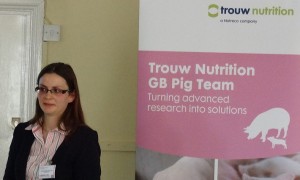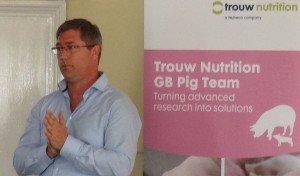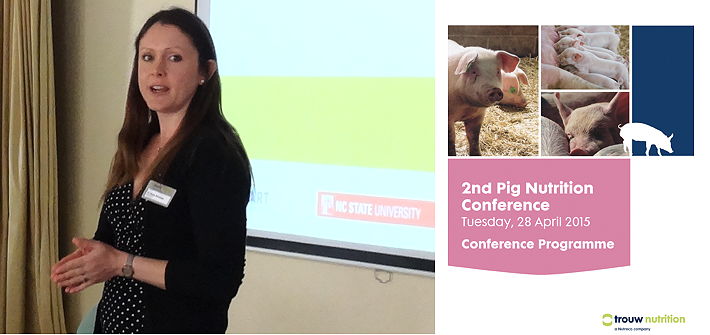Innovation holds the key to improving pig-sector performance and profitability, but with fluctuating feed prices, and a market that’s increasingly constrained by global trading, the challenge to maintain competitiveness continues to exert pressure on genetic development, production systems and management techniques.
These opening comments made by Trouw Nutrition GB pig specialist Dr Sian Nicols (pictured above) at the start of the company’s second Pig Nutrition Conference, framed an underlying theme: the need to focus on the finer elements of pig nutrition and find out more about the intricate processes that influence digestion, maintain gut integrity and optimise enteric health and pig performance.
The topics under review clearly demonstrated what Trouw, and companies like it, are doing to advance pig nutrition and help producers improve productivity and profit margins.
Dr Nicols said the swift response that UK herds had made to raise sow productivity during recent years, and the eager adoption of more precision-based management systems in the rearing and finishing herd, promised greater efficiency and reduced environmental impacts. But these trends were influencing nutritional strategies, and formulators were now faced with new challenges to meet the more specific requirements of individual production processes.
A bespoke approach to diet formulation was emerging, with the development of more precise feeding regimes that better matched pigs’ genetic potential at fundamental stages of the production cycle. This trend would continue to shape pig nutrition, although cost control would remained a pivotal factor and nutritionists were under increasing pressure to find alternative raw materials and establish innovative biological tools capable of improving the digestibility of diverse feedstuffs and novel ingredients.
Developing ways to reduce anti-nutritive factors and enhance digestive integrity would be vital in the quest to feed pigs more effectively and efficiently going forward. A better understanding of intestinal physiology, gut immunity and the interactions between the many complex biological processes involved in the digestive process at every stage in a pig’s life was a priority.

> Dr Melanie le Bon (above)
Nottingham Trent University
Nutritional research was eagerly exploring new methods to optimise the pig’s alimentary health, both physically and microbially, Dr Melanie le Bon said in her paper on pig nutrition, gut health and immunity. She gave an insight into the complex neurology of the digestive system and explained how gut function impacted on brain activity.
The digestive tract had strong nervous pathways that relayed unconscious messages directly to the brain, which often manifested as mood swings and behavioural changes. Consequently, any alterations to gut physiology and/or its microbiota – the vital microbial community that exists within the gut – would create stress. Such “upsets” could significantly affect normal behaviours and therefore influence production potential.
The digestive tract was under threat from a continual pathogenic challenge and the energy required to fend off infection and renew and regenerate tissues was worth consideration, Dr Le Bon added.
“More than 70% of the body’s immune cells are located in the gut,” she said. “It has a rich and complex immune system and any disruption will provoke an immune response that in some way will impact on performance.”
About 20% of nutrients fed to a pig were used to keep the digestive tract working, so minimising upsets and optimising gut function benefitted wellbeing and productivity. Estimates suggested an inappropriate immune response – whether pathogenic or nutritional – could increase a pig’s energy requirements by as much as 25%.
The epithelial cells lining the gut were replaced every three days, although in neonatal pigs this cycle could take up to seven days. This process demanded significant energy, and the first nutrients absorbed by the body were primarily used to repair and maintain digestive system.
Healing process
Dr Le Bon said that the healing process itself was very energy dependent, but in most situations was hindered by the stress and illness caused by the immune challenge and repsonse. Consequently, careful nutritional management was required alongside treatment, particularly if antibiotic medicines were used.
Between 10% and 20% of digestion relied on microbial activity and the degeneration of intestinal microbiota could have a major impact on pig performance. Research was investigating the role bacteria played in digestive processes and within the gut’s complex immune system. Dr le Bon said that gaining a better understanding of how microbial activity influenced alimentary health should offer insights into how to preserve and promote enteric stability, particularly when faced with disease challenges.
Science also aimed to unravel the complexities of dietary intolerance – a nutritional reaction that’s associated with stress and immunity.
Nutritional intolerance often develops when young pigs are exposed to certain nutrients, particularly proteins, before their digestive systems can cope with them. This creates a negative immune response, usually causing inflammation and subsequent enteric problems such as colitis and/or diarrhoea.
But very little is known about intolerance, why it happens, what triggers it or how is can be prevented or reduced, Dr le Bon said. It’s an area that requires detailed investigation, as establishing what’s safe or potentially dangerous could help address many of the difficulties associated with feeding young, immature pigs, particularly post-weaning.

> Dr Pieter Langendijk (above)
Nutreco Research and Development
Traditional ideas about restricting feed intakes in the days following service should be reviewed, according to Nutreco researcher Dr Pieter Langendijk, who told the conference that although prolific dam lines were capable of high ovulation rates and ultimately larger litter sizes, inadequate nutrition during the embryonic stages of pregnancy could be capping reproductive potential.
He said evidence suggested that giving sows high levels of feed post-service could actually enhance hormone activity and improve the uterine environment during the initial stages of gestation. More traditional views, however, opposed this theory, and deemed high feed intakes as dangerous because they may suppress progesterone. This hormone was integral to embryo survival and maintenance of pregnancy, and numerous studies showed that systemic concentrations of progesterone – those detected in the blood stream – could fall rapidly if sows were fed excessively in the initial stages of pregnancy.
However, establishing the true levels of progesterone secreted directly into the uterus by the ovaries was complicated, and said Dr Langendijk noted that conventional blood tests couldn’t accurately detect what was going on at this stage.
“Low systemic concentrations are probably a result of increased liver function, which is stimulated by higher feed intakes and it will filter out progesterone from the bloodstream,” he added. “But the local secretion of progesterone directly from the ovaries into the uterine tract is difficult to measure, and it’s more likely to be higher than assumed.”
Pulse points
Studies measuring progesterone as it was secreted into the vena cava – blood before it reaches the liver – had revealed that this hormone was delivered in pulses, every four to six hours. High-level feeding increased this “progesterone pulse rate”, so it’s fair to assume that the concentrations of hormone moving into the uterus also increases, Dr Langendijk said.
He also commented on other studies where gilts were fasted post service for two to three days to measure circulating progesterone levels. All of them subsequently produced low litter sizes compared with gilts that had received a higher plain of nutrition.
Dr Langendijk said that these observations resonated with many loose-house situations where served sows are fed as a group and there was competition for feed. A proportion of animals wouldn’t get enough to eat during this critical stage of gestation, which meant pregnancy could be compromised. Embryonic mortality would be higher; there was greater chance that these females would return to service; and those that do remain pregnant were likely to have small litters.
He didn’t believe that high feeding levels in early gestation would negatively impact on sow performance, because a uterine environment rich in progesterone at this stage was more likely to support embryo survival rather than compromise it.
Another area Dr Langendijk highlighted was the use of Arginine in sow nutrition. This amino acid influenced vascular development and including it in diets in early gestation could benefit placental augmentation and ultimately pre-natal piglet growth and development.
Foetal weight was related to placental space, and the size and structure of the placenta. Research supported by Nutreco at Wageningen University in Holland had shown that sows fed Arginine from 15 to 28 days gestation produced an extra piglet per litter and the progeny at birth were of a more uniform size.

>Professor Theo van Kempen (above)
Principal researcher, Nutreco
Although vitamin E had become a standard antioxidant in pig diets, nutritionists should be brokering other options that are more bioavailable and cost effective.
Professor Theo van Kempen, a principal researcher for Nutreco R&D, said vitamin E was one of the most expensive ingredients in a premix formular, yet it wasn’t necessarily the best means of dealing with oxidative stress and the cell degradation created by the free radicals it generated. Countering these damaging effects could now be achieved using a variety of nutritional tools and nutritionists should be considering what else was on offer.
“The way vitamin E is synthesised is very specific,” he said. “Pigs can absorb about 29% of a natural supply, but the bio-availability of synthetic vitamin E, which is used by most feed companies, is poor at around 20% and we must be aware of this.”
The way vitamin E was “packaged” in a feed also had implications. In milk, it was well present and young pigs found it easy to metabolise. However, when included in typical diets the bio-availability fell away, so it may not be so easy for the pig to achieve sufficient uptakes.
“Saturating diets with vitamin E has no recompense as adding more makes no difference, Prof van Kempen said. “National recommended concentrations (NRCs) haven’t been reviewed for 40 years and work needs to be done to establish what is really required by today’s genotypes.”
A plethora of alternative antioxidants had been discovered and were suitable for livestock diets and they offered pig nutritionists a better means of mopping up free radicals and controlling oxidative stress in pigs, and in most cases were very cost effective.
Polyphenols warranted further investigation, Prof van Kempen added. Many of these plant-derived compounds were much more potent than vitamin E and although bio-availability could vary from zero to 80%, technology was available that could access their unique properties.
“From a nutritional perspective, we must take a more balanced approach when addressing oxidative stress,” he said. “For livestock, we need to evaluate the benefits of using particular compounds, understand what they are doing and the value of using them. Compounds such as polyphenols might fulfil the role much more effectively and economically than more traditional ingredients.”

> Hubert van Hees (above, right)
Nutreco’s research and development
Echoing Dr le Bon’s thoughts on immune health, Hubert van Hees, from Nutreco’s research and development team, said establishing gut stability and immune competence early in a pig’s life was a foundational requirement.
Science was looking more closely at neo-natal digestive systems and how maternally derived immunity (MDA) influenced intestinal physiology and the gut’s response to pathogenic and nutritional challenges. Where enteric health was concerned the “gap” between passive MDA immunity and the development of a mature, active immune system still remained a mystery, yet what happened at this critical time often dictated how a pig coped with alimentary challenges through its lifetime.
Mr van Hees explained how the sterile neo-natal gut was colonised by microbial organisms soon after birth. Piglets were protected by MDA during this very sensitive period, and the gradual exposure to environmental microflora during those first few days stimulated a positive immune response and encouraged microbial diversity in the intestines. However, if this colonisation was too rapid, happened to soon or was suppressed in some way, this caused inflammation, infection and auto-immune responses that might perpetuate throughout the pig’s life.
Research in the Netherlands had shown that using amoxicillin antibacterial treatments in sows pre-parturition and post-farrowing impacted on piglets’ microbiotic development. The effects induced changes in gut colonisation that were still influencing microbial diversity in these pigs right up to slaughter.
Mr van Hees also highlighted the detrimental effects that weaning induced on gut colonisation, explaining it could take between three to four weeks for a pig to restore the microbial diversity of the intestinal flora it had before it was weaned. He said failing to recognise the importance of gut stability and enteric health at this critical stage would also negatively affect growth and performance throughout the production process.
Producers should also focus on the quality of their weaned piglets rather than the numbers of pigs weaned per sow, Mr van Hees said. Although birthweight was important, overall it only accounted for 30% of the final weaning weight.
“Producers and their nutritional advisers shouldn’t underestimate the value of creep feeding, particularly with large litters,” he added. “The increasing prolificacy of dam lines means more nutritional intervention will be necessary pre-weaning.”
Gaining a better understanding of a piglet’s nutritional needs during the first weeks of life would enable nutritionists and producers to optimise digestive development and reduce the risk of long-term enteric problems occurring.
> Dr Angela Riemensperger
Danisco Animal Nutrition
The use of non-starch polysaccharide (NSP) enzymes to improve the digestibility of monogastric diets is not new, but with increasing pressure to use alternative feed ingredients, and reduce environmental impacts, these tools are proving valuable assets.
Dr Angela Riemensperger, technical manager with Danisco Animal Nutrition (DuPont), reviewed current trends and said although the initial focus for NSP enzymes had been environmental, results from trials together with on-farm experiences had proved these nutritional additives could achieve far more than just manure reduction.
Enzyme technology provided a means of unlocking nutrients from more fibre-rich feeds and had also been found to benefit gut health and intestinal integrity, Dr Riemensperger said. Technical advances had improved the thermal stability of NSP enzymes in the manufacturing and blending process, so inclusions were easier and diets containing enzymes were consistently showing improvements to pig performance in both sows an finishing pigs.
Improved digestibility, better nutrient uptakes and greater acidification were just a few of the acknowledged benefits of using enzymes in pig production, while evidence from the poultry sector revealed that inclusion of xylanase and ß-glucanase enzymes was aiding volatile fatty acids levels in the gut and improving health and productivity.
Such advances were likely to be replicated in pigs, and these results were also setting a precedent for future research and where enzyme technology should be directed, Dr Riemensperger said.




